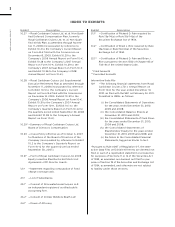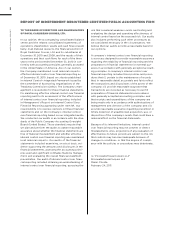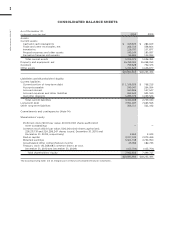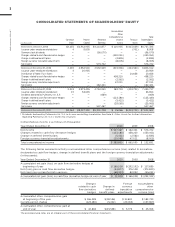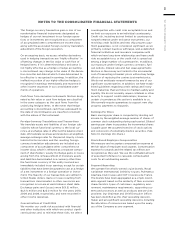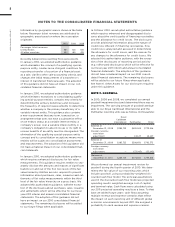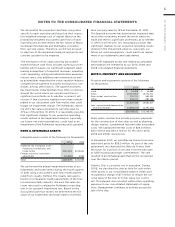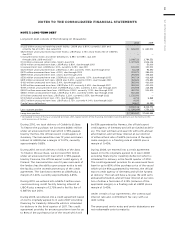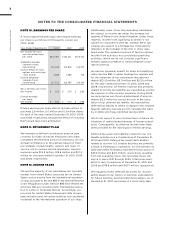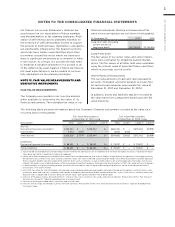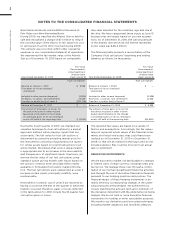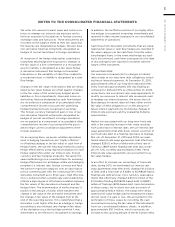Royal Caribbean Cruise Lines 2010 Annual Report Download - page 73
Download and view the complete annual report
Please find page 73 of the 2010 Royal Caribbean Cruise Lines annual report below. You can navigate through the pages in the report by either clicking on the pages listed below, or by using the keyword search tool below to find specific information within the annual report.
2010 ANNUAL REPORT 70
NOTES TO THE CONSOLIDATED FINANCIAL STATEMENTS
Information by geographic area is shown in the table
below. Passenger ticket revenues are attributed to
geographic areas based on where the reservation
originates.
Passenger ticket revenues:
United States
All other countries
Recently Adopted Accounting Pronouncements
In January 2010, we adopted authoritative guidance
which eliminates the concept of a qualifying special-
purpose entity, creates more stringent conditions for
reporting a transfer of a portion of a financial asset
as a sale, clarifies other sale-accounting criteria, and
changes the initial measurement of a transferor’s
interest in transferred financial assets. The adoption
of this guidance did not have an impact on our con-
solidated financial statements.
In January 2010, we adopted authoritative guidance
which eliminates exceptions to consolidating qualify-
ing special-purpose entities, contains new criteria for
determining the primary beneficiary and increases
the frequency of required reassessments to determine
whether a company is the primary beneficiary of a
variable interest entity. This guidance also contains
a new requirement that any term, transaction, or
arrange ment that does not have a substantive effect
on an entity’s status as a variable interest entity, a
company’s power over a variable interest entity or a
company’s obligation to absorb losses or its right to
receive benefits of an entity must be disregarded. The
elimination of the qualifying special-purpose entity
concept and its consolidation exceptions means more
entities will be subject to consolidation assessments
and reassessments. The adoption of this guidance did
not have a material impact on our consolidated finan-
cial statements.
In January 2010, we adopted authoritative guidance
which requires enhanced disclosures for fair value
measurements. This guidance requires entities to sep-
arately disclose the amounts and reasons of significant
transfers in and out of the first two levels of the fair
value hierarchy. Entities are also required to present
information about purchases, sales, issuances and set-
tlements of fair value measurements within the third
level of the fair value hierarchy on a gross basis. We
adopted this authoritative guidance, with the excep-
tion of the disclosures about purchases, sales, issuance
and settlements which will be effective for our fiscal
year 2011 interim and annual consolidated financial
statements. The adoption of this guidance did not
have an impact on our 2010 consolidated financial
statements. The remaining disclosures will be added
to our future filings when applicable.
In October 2010, we adopted authoritative guidance
which requires enhanced and disaggregated disclo-
sures about the credit quality of financing receivables
and the allowance for credit losses. The disclosures
provide additional information about the nature of
credit risks inherent in financing receivables, how
credit risk is analyzed and assessed in determining
the allowance for credit losses, and the reasons for
any changes to the allowance for credit losses. We
adopted this authoritative guidance, with the excep-
tion of the disclosures of reporting period activity
(e.g. rollforward disclosures) which will be effective for
our fiscal year 2011 interim and annual consolidated
financial statements. The adoption of this guidance
did not have a material impact on our 2010 consoli-
dated financial statements. The remaining disclosures
will be added to our future filings when applicable.
See Note 6. Other Assets for our disclosures required
under this guidance.
NOTE 3. GOODWILL
In 2010, 2009 and 2008, we completed our annual
goodwill impairment test and determined there was no
impairment. The carrying amount of goodwill attribut-
able to our Royal Caribbean International and the
Pullmantur reporting units was as follows (in thousands):
Royal
Caribbean
International
Pullmantur Total
Balance at
December 31, 2008
Foreign currency
translation
adjustment —
Balance at
December 31, 2009
Foreign currency
translation
adjustment — () ()
Balance at
December 31, 2010
We performed our annual impairment review for
goodwill during the fourth quarter of 2010. We deter-
mined the fair value of our reporting units which
include goodwill, using a probability-weighted dis-
counted cash flow model. The principal assumptions
used in the discounted cash flow model are projected
operating results, weighted-average cost of capital,
and terminal value. Cash flows were calculated using
our 2011 projected operating results as a base. To that
base we added future years’ cash flows assuming
multiple revenue and expense scenarios that reflect
the impact on each reporting unit of different global
economic environments beyond 2011. We assigned a
probability to each revenue and expense scenario.


